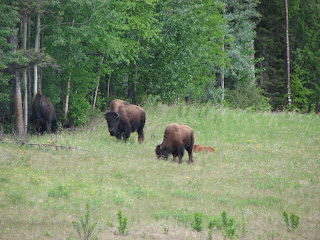Day 41, Tuesday, 5/29/18
Teslin, YT
It was a bit of a gray morning in Skagway, with four cruise ships already docked. Chris decided to check out the museum and I took a hike up to and around
Lower Dewey Lake. It's a short hike, about 5 miles with an elevation gain of 500 feet. The start of the trail was clogged with people from the boats but thinned out considerably near the start of the loop around the lake.
 |
| petroglyph? |
As I walked up the path, I noticed a carving in the rock face. The carving is similar to other Tlingit petroglyphs showing a human face (
here, bottom). It looked like it had been there awhile, but no idea how long.
Along the south side of the lake were remnants of a railroad track. Coming back down, the trees opened up, providing a good view of the harbor.
 |
| Lower Dewey Lake |
|
 |
| Abandoned Tracks |
|
 |
| Skagway Harbor |
|
The Museum contained a variety of artifacts and stories from the gold rush days and stories of the prospectors climbing the trails and passes to get to the gold!! It also highlighted the area's history of the trade routes of the Chilkat Tlingit First Nation people.
After the hike, I met Chris at the Skagway library. Walking back through town to the van was like navigating rapids - people everywhere! Back in the van, we hightailed it out of town back to the Yukon.
Things always look different going over the same road but in the opposite direction. Driving into Skagway we were focused ahead, not where we'd come from. The modern mountain pass road through White Pass (finished in 1978) roughly follows the path taken by the stampeders during the Klondike Gold Rush. A stampeder was required by the RCMP to carry a year's worth of supplies, probably close to a thousand pounds of gear and food. Arriving in Skagway and facing the pass must have given more than one prospector second thoughts!
 |
| White Pass |
|
 |
| White Pass |
|
 |
| White Pass and Yukon Route Railroad |
|
The landscape just beyond the top of the pass (~3300 feet) is rugged and still had snow. Except for the snow capped mountains, it reminded me of Acadia's rocky landscape. The Emerald lake stretched on to the right for miles.
Just past Canadian customs, we spotted a black bear on the side of the road. We were far enough away when we stopped that it didn't appear to notice us, though that may also be because it's been habituated to cars.
Between White Pass and the town of Carcross, the road follows Tutshi and
Bennett Lakes. Bennett was where the
Chilkoot Trail ended and the stampeders left land headed for the Yukon River via water. Both Tutshi and Bennett are large lakes, approximately 22 and 50 miles respectively. The White Pass and Yukon Railroad runs along Bennett and some of the smaller lakes.
 |
| White Pass and Yukon Route Railrtoad |
|
 |
 |
Back on the ALCAN, we crossed the Teslin River at Johnson's Crossing (population 15) and then southeast along Teslin Lake. The views, of course, were lovely.
 |
| Still Cold! |
In
Teslin, we stayed at Yukon Motel and Lakeshore RV Park. We found a nice site at the back of the park, right on the lake. We watched the full moon rise while the midnight sun would not give way to the night!!
Teslin is home to the Teslin Inland Tlingit First Nation. In Canada, the term 'First Nation' replaced the term 'Indian Band'.



























































